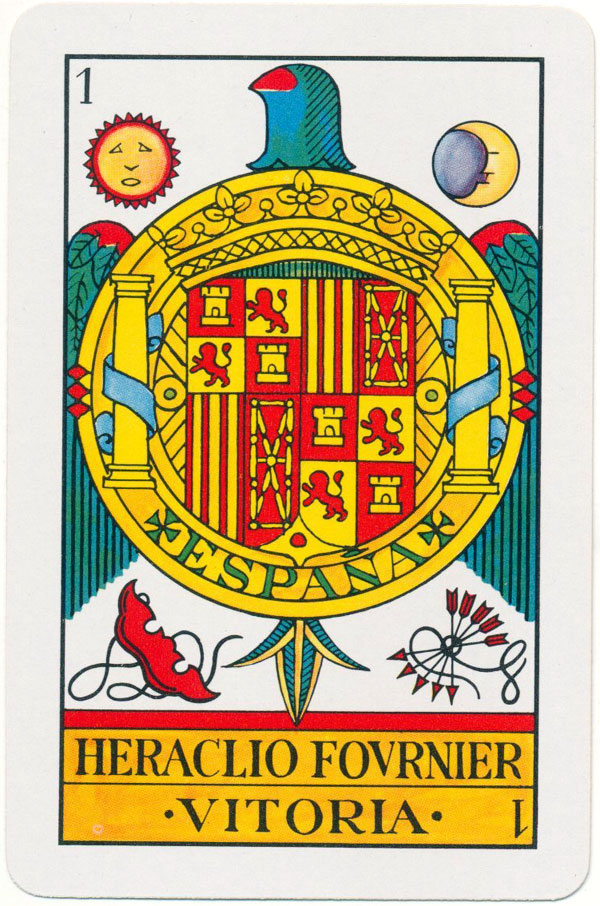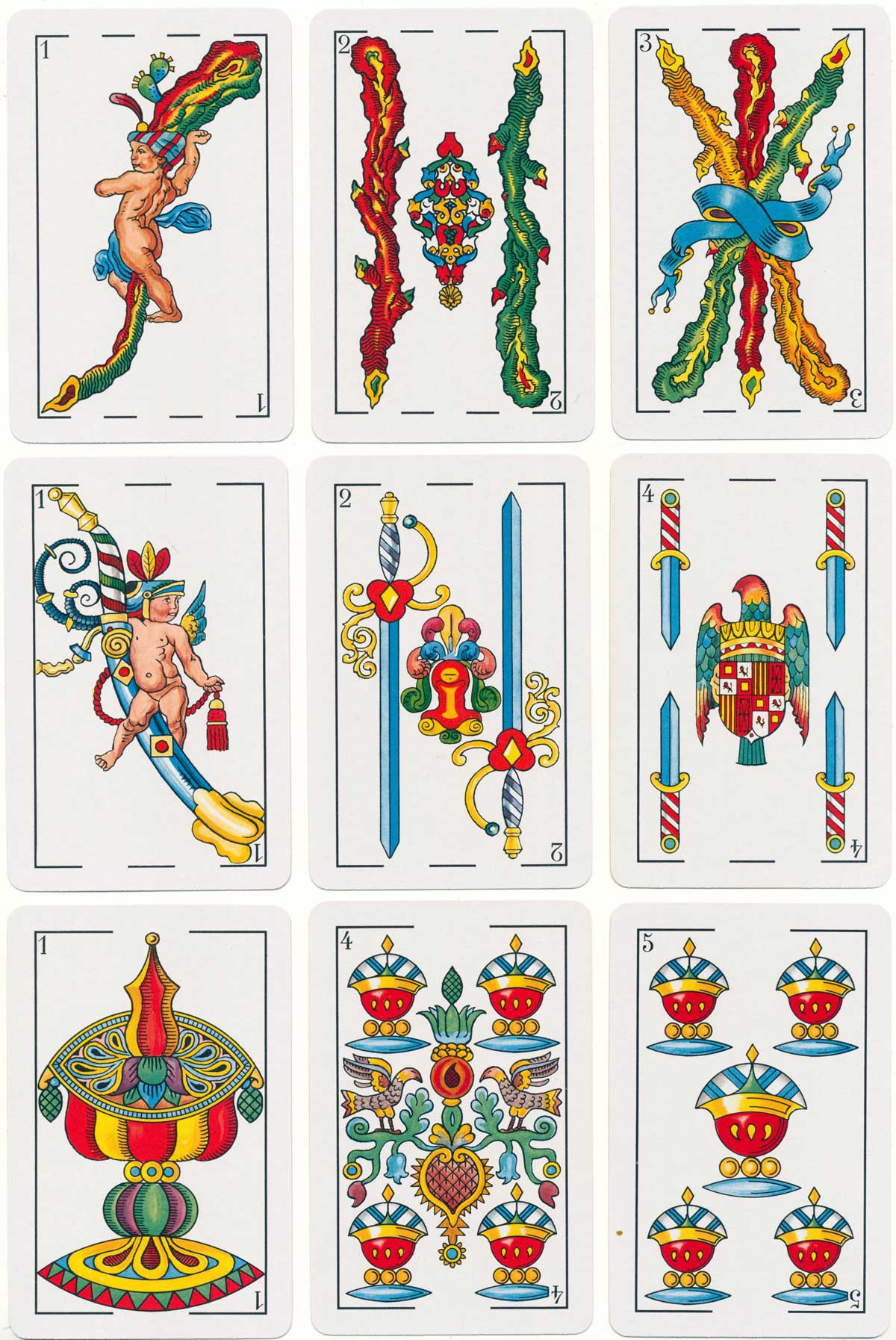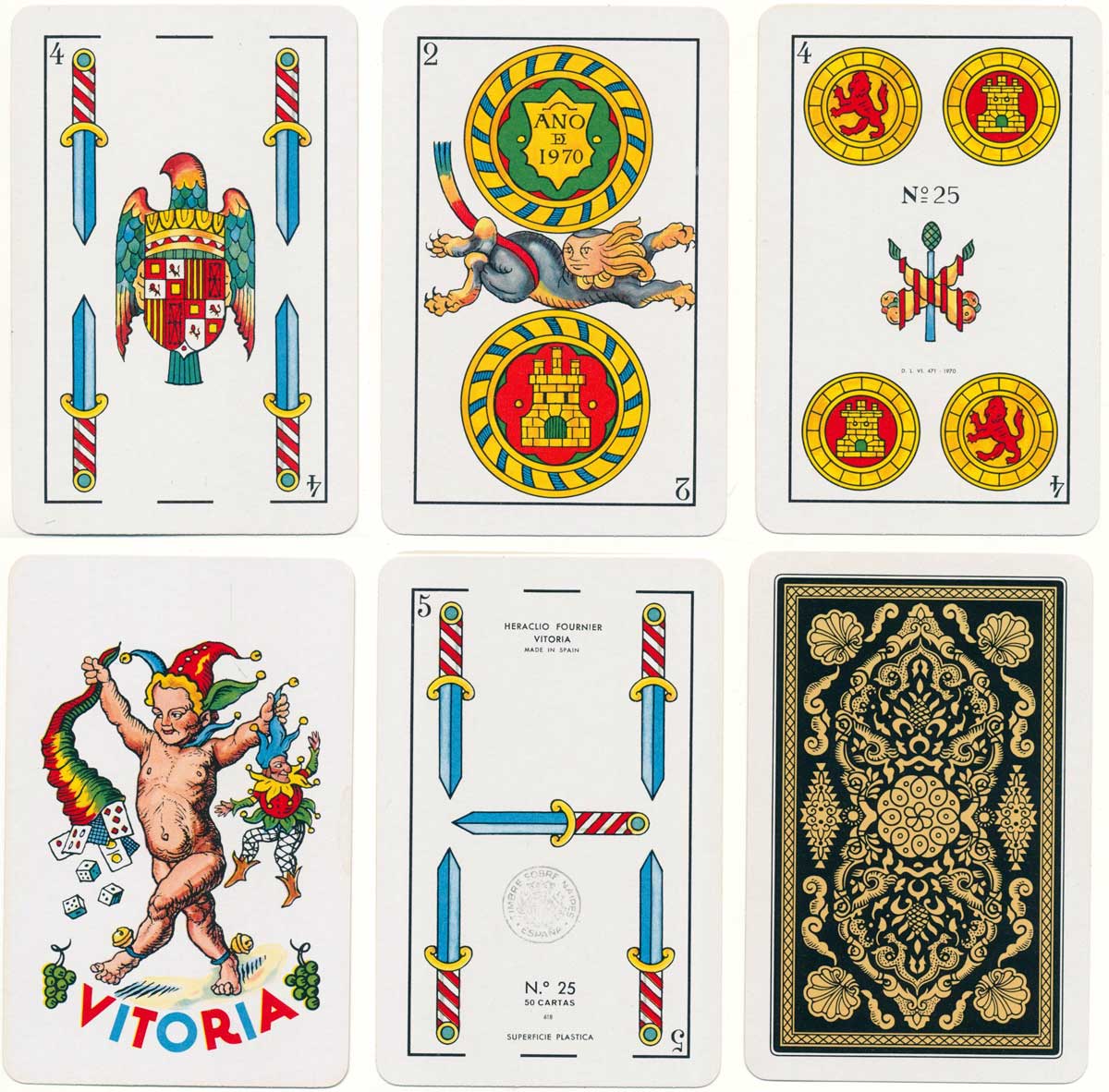Naipe Nacional
Naipe Nacional designed by the architect, illustrator and artist Luis Alemany (1886-1943).
Fournier’s “Naipe Nacional”, designed by the architect, illustrator and artist Luis Alemany (1886-1943), was first published in 1938 at the time when the Spanish Civil War was imminent, leading to Francisco Franco’s dictatorship until his death in 1975. The designs are aimed at promoting the values and ideals of an enduring and traditional national identity, alluding to the Spanish Reconquista and Renaissance which ushered in the golden era of the Spanish colonial empire. The pack’s composition loosely follows a “Four Cultures” format.
Right: the striking and emblematic “imperial” ace of coins →
Alemany was inspired by the futurist italian, constructivist, rationalist and cubist art movements in stark contrast to the conservative national style of the day. The popularity and success of the project is shown by the successive editions which have appeared, in various formats and in which the symbolism has been slightly changed or updated, to reflect political circumstances of the time. This is the 1970 edition which is mainly based on the 1939 edition with some small changes.



Above: reprint of Fournier’s “Naipe Nacional” No.25, designed by Luis Alemany, which was first published by Hijos de Heraclio Fournier in 1938. The date of this edition appears on the two of coins. Images courtesy Matt Probert & Ib Hilmar Hedegaard.
REFERENCES
Pérez González, Juan Ignacio & Alberto: Luis Alemany y la Baraja Nacional, Fundación Sancho el Sabio Fundazioa (Vitoria-Gasteiz), 2016

By Matt Probert
Member since March 02, 2012
I have adored playing cards since before I was seven years old, and was brought up on packs of Waddington's No 1. As a child I was fascinated by the pictures of the court cards.
Over the next fifty years I was seduced by the artwork in Piatnik's packs and became a collector of playing cards.
Seeking more information about various unidentified packs I discovered the World of Playing Cards website and became an enthusiastic contributor researching and documenting different packs of cards.
I describe my self as a playing card archaeologist, using detective work to identify and date obscure packs of cards discovered in old houses, flea markets and car boot sales.
Related Articles

Pierre Varangot
Tracing the origins, legality and legacy of Pierre Varangot’s San Sebastián deck.

Archaic Spanish-suited pattern from Bayonne
Archaic Franco-Spanish pattern from Bayonne by a manufacturer with the initals M.V.

Tarot de las Coscojas
Historical playing card design, tarot symbolism and an almost psychedelic medieval surrealism.

Tarot de Valverde de la Vera
A series of 24 surrealist engravings by Mexican artist Claudio Favier in which archetypal Tarot alle...

Baraja de Juan Martín Zamorano
Deck inspired by El Pendón de los Zamorano, a military pennant dating from 1501, published by Priego...

Heráldica Castanyer No. 16
Strange variant of international pattern cards for poker or bridge.

Fantasy Spanish-suited deck
Fantasy Spanish-suited deck by Bertschinger y Codina, Barcelona.

Bertschinger y Codina - Cartes Françaises
French ‘Paris’ pattern made by Bertschinger y Codina, Barcelona, c.1850.

Braulio Fournier
Baraja Nº 1 produced by Braulio Fournier, Burgos, c.1868.

Pirritx eta Porrotx
Happy Families card game from the Spanish Basque Country.

Naipe Vizcaino
‘Naipe Vizcaino’ designed by Javier Urkiri and published by Industrias Gráficas Castuera and the Caj...

Baraja Turística del País Vasco
Basque poker deck of 55 cards published by Fournier with scenic views of the Basque Country.

Baraja Vasca
Spanish Basque Country deck with original drawings by María Isabel Ibañez de Sendadiano.

Baraja Cultura Española
ASESCOIN pack for 2022 designed by M.A. Corella featuring famous Spaniards and notable buildings.

Laurenzo Propagine
Spanish-suited cards made in Italy by Laurenzo Propagine.

Jeu de 7 familles Les Dynasties d’Artisans Basques
Long-standing Basque businesses represented in a traditional card game with illustrations by Odile A...
Most Popular
Our top articles from the past 28 days

